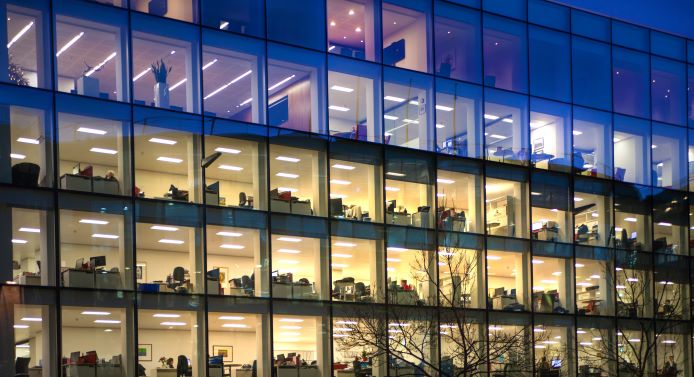As we step back into the real world following the pandemic, many businesses are resuming their operations in London and returning to physical office s
As we step back into the real world following the pandemic, many businesses are resuming their operations in London and returning to physical office spaces. It almost goes without saying, but there are lots of benefits to working out of a central headquarters, be it full-time or as part of a hybrid-remote schedule. With more time face-to-face, your company can boost collaboration and establish clearer boundaries between work and home life — not to mention build productive colleague relationships in London’s great selection of bars and restaurants.
But as a business owner, how can you make your London workspace appealing enough for employees to come back to their daily commute into the city centre? This is where we come in — we’ve done the research and compiled our four top tips to help you improve the office. Let’s get to work.
1. Keep it clean
The World Health Organization has recently declared that the end of the pandemic is “in sight”. But in spite of this, many still have fears about returning to city centres, using public transport, and sharing facilities with large numbers of people that they may consider non-essential contacts. To improve your office’s hygiene and safety standards, routine cleaning is essential.
A number of London-based commercial cleaning companies offer Covid-19 policies to address health concerns in the workplace. Take NuServe, which describes the importance of “more visible cleaning to provide hygiene assurance and help encourage staff back into the office”, something that typically comprises “disinfections of Covid-19 touch points” for employee peace of mind. A successful return to the office will be inclusive of all workers, counting those more worried or vulnerable to Covid-19, flu and other seasonal illnesses.
In addition to improving health and safety standards for staff, a clean and tidy workspace could promote more productive work. Chances are, your colleagues don’t do their best work in cluttered, uninviting environments — and many home-workers with children are probably looking forward to returning to the office and escaping just that.
2. Use biophilic design
Set amid the concrete jungle of London, incorporating plants into your workspace can make it a more visually appealing and even more productive space. One study conducted by researchers at the University of Exeter showed that a “green” commercial office filled with plants benefited productivity by up to 15% when compared to a “lean” workspace without.
Whether you’re creating your urban oasis with potted plants, hanging baskets or wall-crawlers, the plants that you add to your space will need certain environmental conditions. Thankfully, offices that use biophilic design features that emulate the natural world, also known as “biophilic” elements, can provide these and improve employee well-being. For example, large windows that let in a lot of natural light and high ceilings that open up the space have been shown to reduce stress among workers.
Though you may need to do some internal alterations or consider a post-remote relocation, features like these are the perfect fit for a new and improved London workspace, helping your staff to escape from the hustle and bustle of city life.
3. Colour it bold and bright
While you’re busy filling your space with green, think about the rest of your colour palette too — an appealing interior design can make all the difference to your office. Gone are the days of murky grey walls and clinical overhead lighting — your staff will be used to cosy home setups of their own curation, so you’ll have to upgrade the aesthetics if you want to compete.
When selecting your new decor, bear in mind the principles of colour psychology — a bold and well-considered palette is the best route to success. According to SEC Interiors, warmer hues like oranges and yellows are the best choice for common areas, as they stimulate positivity and teamwork — while cooler blue tones boost “relaxation and intellectual thought”.
Interesting art prints and photos hung on the wall can also help to inject some warmth and personality, facilitating the “home from home” feeling that employees might look for as they leave their kitchen office setups for the city. This would be a wise time to have new headshots taken and decorate the walls with them, something that will also emphasise your unified company culture.
4. Integrate social areas
Some of the key reasons that leaders are bringing work back to the office are to build team relationships and develop the company culture. While technologies like cloud computing suites and digital meetings have streamlined remote work, 45% of surveyed workers believe that teamwork has declined since the pandemic began, and many of us are struggling with Zoom fatigue.
So, as your staff return to the office, you should consider giving them dedicated social areas to catch up, collaborate and get to know each other better, rather than leaving them to build productive working relationships around the water cooler. Plenty of modern London offices are decked out with comfy breakout seating areas, collaborative desk space and even fun activity zones for sports or gaming. Incorporating features like these can help to bring your team together and facilitate relationships outside of email threads — boosting morale and providing places to decompress.
By making simple improvements to your office environment, you can ensure that you are inviting your workforce back to a clean, productive, inspiring and sociable space. After years of pandemic disruptions, they deserve no less — and you can be assured as a business owner that you are maximising both their well-being and productivity.



















































































































COMMENTS